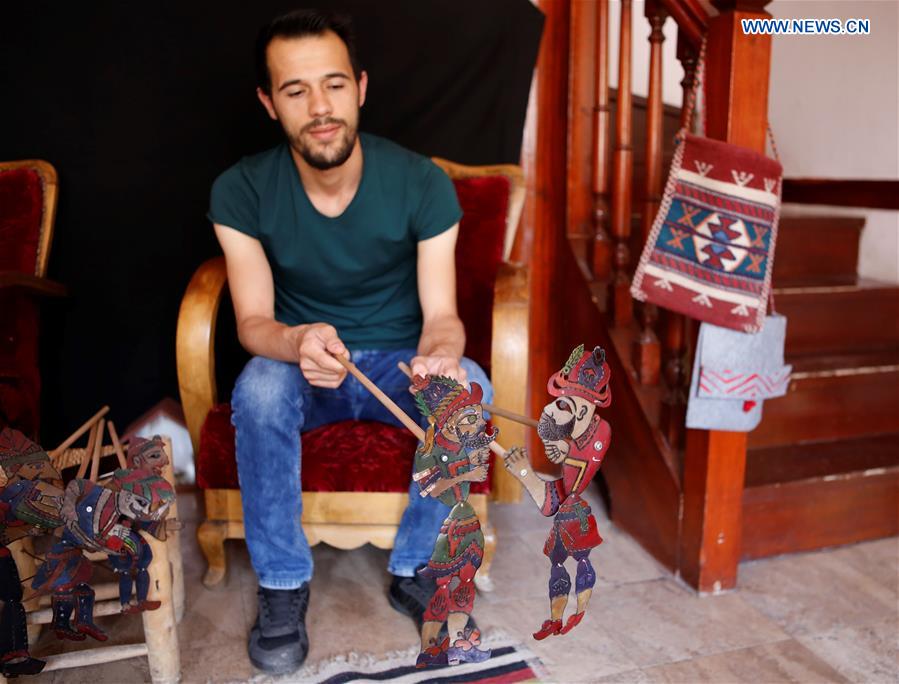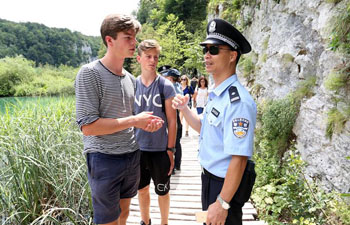
An artist shows the puppets of traditional shadow puppet show in Ankara, Turkey, on July 25, 2018. The shadow play of Karagoz and Hacivat, main art form of the traditional Ottoman theater, survives in modern Turkey and is still a popular entertainment especially for child audience. (Xinhua/Qin Yanyang)
ANKARA, July 28 (Xinhua) -- The shadow play of Karagoz and Hacivat, main art form of the traditional Ottoman theater, survives in modern Turkey and is still a popular entertainment especially for child audience.
This form of shadow theater is established as a Turkish storytelling tradition and the plays are generally associated with the feasting month of Ramadan, when the cinema, television, radio and Internet were not invented to spoil social life.
It is difficult to point out where the ancient tradition of shadow play came to Ottoman Turks, but scientists suggest that it might originate from China, India or Byzantine Greece.
At present, a similar cultural heritage is also well kept in China, namely Chinese shadow puppetry, as an icon of humanity communication along the ancient silk road.
The comical plays were improvised for local audiences in coffee shops, private homes or public squares in the past. Now, such culture survives in a toned-down form for restricted audiences in limited locations where skilled puppeteers struggle to transfer the tradition to young minds.
One of the locations is the Ankara Intangible Cultural Heritage Museum, a place aiming to protect the folklore, practices, arts and narrative traditions.
Turkish folklore studies have particularly focused on the northwestern city of Bursa, the second capital of the Ottomans before the seizing of Constantinople in 1453, said the coordinator of the museum Tarkan Korkmaz, 24, who is also a puppeteer.
"Researchers say that the shadow play came to Anatolia from China or India, but according to the official version, this art form came to Istanbul from Egypt when it was conquered by the Ottomans," in early 16th century, Korkmaz said in his costume before a show in the museum, located in old-town Ankara, one of the capital's tourist attractions.
It may well be that Karagoz and Hacivat lived in Bursa during the early 15th century. Because of their constantly bickering over trivial matters as construction workers of a mosque, they were executed by the sultan of the time, who was furious that they had perverted fellow workers with their incessant jokes, according to scholars.
However, some people say it is a pure legend, nevertheless their monumental tomb stands in Bursa today.
The main purpose of the performance is to make the audience laugh by intricate plots and improvisations of master puppeteers.
There could be as many as four puppeteers performing at once, depending on the number of puppets that would be used during the event, using different voices and accents of the ethnic minorities of the time such as Armenians or Greeks.
Korkmaz, who also makes his own puppets, said that even though the play now attracts mostly children, in the past, it was for adults.
"This play was in fact not for children in the past because there was a lot of harsh criticism on daily events and foul mouthed comments but it was toned-down with time and today children are very fond of it," he said.
The shadow play depends mostly on the talent of puppeteer, who stands behind a curtain and controls several colored, semi-transparent and jointed limbs puppets, generally made from camel or water buffalo skin on a white curtain.
Some of the puppets have many joints, and are usually 30-40 centimeters high.
The plays are generally filled with double-entendres, irony, satire and also exaggerations. The performance consists of three parts: a prologue or introduction, then a dialogue and interlude and finally the main plot with a brief conclusion.
Korkmaz tries to keep children's attention to the performance by introducing new features such as social media.
In the play, the performance always ends with Hacivat shouting, "you have brought the curtain down, you have ruined it!" The good-natured Karagoz replies, "may my mistakes be forgiven," as the lamp behind the curtain fades away in a world of make-believe.















